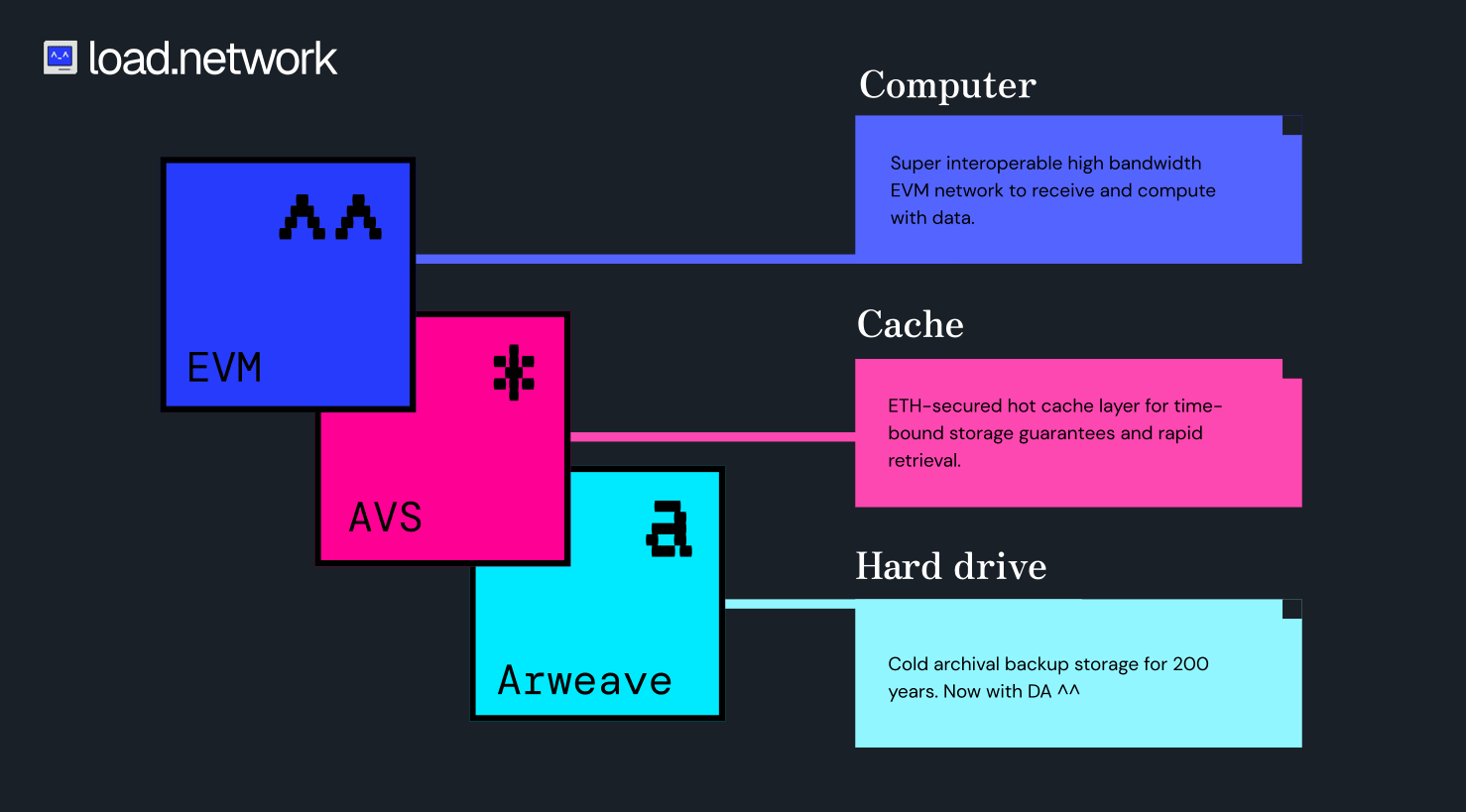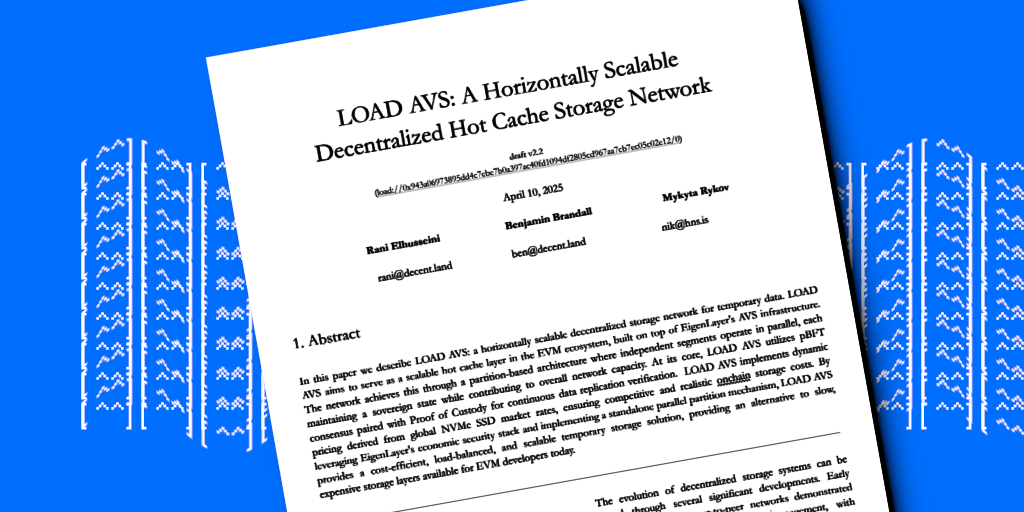If you’ve been following Load Network’s development, you’ve seen the architectural vision:
- EVM in the front (data entrypoint – maximizing interoperability)
- AVS in the middle (hot cache layer – maximizing security)
- Arweave behind the scenes (cold storage – maximizing permanence)
We’ve written a lot about our EVM side, and how we integrate Arweave, but what about the AVS component? What exactly is it, and why does it matter?
Today, we’re breaking down the recently published LOAD AVS whitepaper in plain language to explain Load’s architecture, what role hot cache storage plays, and the use cases it’ll unlock.
The Problem: EVM Storage is Expensive and Complicated
Let’s start with the problem LOAD AVS aims to solve. Currently, decentralized storage in the Ethereum ecosystem faces three major challenges:
- Cost inefficiency: Storing data on solutions like EthStorage costs about 4.43 ETH per GB. That’s prohibitively expensive for most applications.
- Limited scope: Most existing solutions focus on small-scale storage needs – blobs, metadata, things which don’t take up precious space.
- Poor integration: Current solutions don’t integrate well with industry-standard storage approaches, creating unnecessary complexity.
Actually, Load Network itself needs a hot cache storage layer. As a high-performance blockchain, Load Network prunes its history after one month to maintain speed and efficiency. While this pruned data is permanently archived on Arweave, we need a middle-ground solution for data that needs to remain highly available after pruning but before it needs permanent storage.
LOAD AVS: The Hot Cache Layer
So what exactly is LOAD AVS? In simple terms, it’s a decentralized temporary storage network that acts as a “hot cache” for the EVM ecosystem.
Think of LOAD AVS as Load Network’s RAM - fast, efficient, and perfect for data you need quick access to - while solutions like Arweave function more like deep cold storage. LOAD AVS isn’t meant to replace permanent storage solutions but to complement them by providing:
- Affordable time-bound storage (minutes, months, years)
- Strong data availability guarantees
- Easy integration with EVM-based applications
- Programmable at the smart contract layer
- Bucket-Object storage model
How It Works: The Architecture Simplified
Partition-Based Architecture
Rather than having one monolithic network, LOAD AVS is split into “partitions.” Each partition:
- Contains 1-4 operators (storage providers)
- Can store 500-2000 GB of data
- Operates independently while contributing to the overall network
This design allows the network to scale horizontally. Add more partitions to increase capacity.
Bucket-Object Storage
LOAD AVS implements a familiar bucket-object storage model similar to AWS S3 or Google Cloud Storage:
- Buckets: Containers for your data, created in specific partitions
- Objects: Individual pieces of data stored within buckets
There are two bucket types:
- Fixed Allocation Buckets (FAB): Reserve a specific amount of space in advance
- Ghost Buckets: Flexible storage that scales with your needs and can be automatically pruned when empty
Real-World Storage Pricing
Unlike most crypto projects with volatile token-based pricing, LOAD AVS:
- Prices storage in USD
- Derives costs from real-world NVMe SSD market rates
- Uses stablecoins for payment
- Implements a transparent formula that considers hardware costs, replication, and duration
Based on current simulations, storing 1GB for a month costs approximately $0.0307 - significantly cheaper than alternatives while providing 4x data replication for reliability.
How LOAD AVS secures data
For the technically curious, here’s how LOAD AVS ensures honest operation:
EigenLayer Integration
LOAD AVS is built as an Actively Validated Service (AVS) on EigenLayer, leveraging Ethereum’s economic security through restaking. This means operators have significant financial incentives to be honest.
Proof of Storage Challenges
Operators must respond to regular storage challenges that verify they’re actually storing your data. The whitepaper introduces a novel approach called “Proof of Probabilistic Chunk-Sampling Hash” (PoPCSH) which:
- Requires operators to sample portions of stored data
- Makes it computationally expensive to cheat
- Ensures data integrity without excessive computation
pBFT Consensus
For validating storage operations, LOAD AVS implements a practical Byzantine Fault Tolerance (pBFT) consensus mechanism where operators vote to validate:
- Object data structure
- Correct data seeding
- Sufficient user credit balance
- Available network storage capacity
Real-World Applications: What Can You Build with LOAD AVS?
LOAD AVS enables a wide range of use cases:
- Decentralized Data Lakes: Build open, collaborative data ecosystems
- Smart Contract Interoperability: Enable trustless contract-to-contract interactions
- AI Agent Infrastructure: Support web-aligned AI with reliable data storage
- DePIN Support: Provide a storage backbone for Decentralized Physical Infrastructure Networks
- Web Content Hosting: Host static websites with decentralized content delivery
- Decentralized File Sharing: Share files securely in a peer-to-peer fashion
- EIP-4844 Data Longevity: Extend the lifetime of data blobs beyond their normal pruning period
- EIP-4444 Storage: Store historical chain data for networks implementing pruning
The Economics: Sustainable for Both Users and Operators
The whitepaper includes detailed economic analyses that show:
- Users benefit from predictable, market-based pricing
- Operators can achieve ROI in approximately 4.28 months under optimal conditions
- Hardware lifecycle considerations are built into the model
- The system naturally incentivizes honest behavior
A 500GB NVMe SSD operator node costs about $50 in hardware and generates approximately $11.70 monthly in revenue. With 4 nodes in a partition, the break-even point comes in just over 4 months, with the hardware expected to last around 14.5 months before replacement.
Why LOAD AVS Matters for Web3’s Future
We built LOAD AVS because there’s nothing on the market that fills the gap in our stack, and we know other projects feel the same.
- It fills a critical gap in the web3 storage stack between permanent storage and ephemeral data
- It brings real-world economics to decentralized storage, making it predictable and sustainable
- It’s built for horizontal scaling, allowing it to grow with demand
- It complements Load Network’s high-performance design by extending data availability beyond the pruning horizon
Most importantly, LOAD AVS makes decentralized storage practical for mainstream applications. At $0.0307 per GB per month, it’s practically in the same range as centralized alternatives, but with all the benefits of decentralization.
Conclusion: The Path Forward
The LOAD AVS whitepaper outlines a technical solution that rethinks how decentralized storage should work. By focusing on real-world hardware economics, practical scaling, and sensible time horizons, it creates a solution that can actually be used in production applications.
As development continues, we’ll be sharing more about how you can integrate with LOAD AVS and start building applications that leverage this new storage layer. Whether you’re building DeFi applications, AI tools, or entirely new categories of web3 applications, LOAD AVS aims to provide the storage infrastructure real projects need but can’t access today.
Stay tuned for more updates as we move from whitepaper to implementation!


